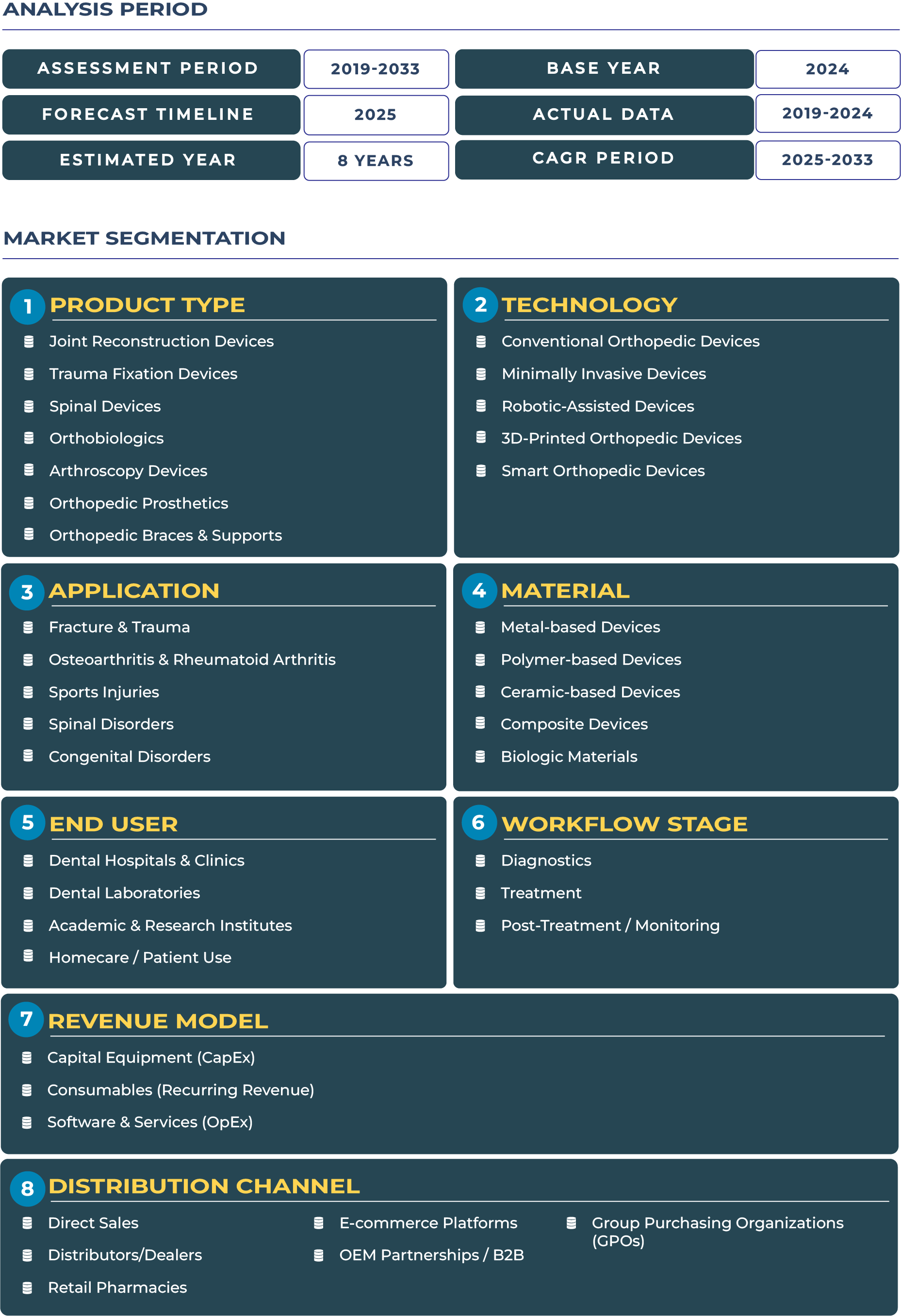Peru Orthopedic Devices Market Outlook: Peru’s Healthcare Modernization Driving Initial Orthopedic Demand
Peru’s healthcare landscape is undergoing steady modernization, reshaping access to advanced medical technologies and surgical interventions. This reform-driven environment is directly influencing the orthopedic devices market, where demand is being fueled by rising investments in both public and private healthcare facilities. By 2025, the market is expected to reach USD 270.1 million and further expand to USD 527.3 million by 2033, advancing at a CAGR of 8.7% from 2025 to 2033. The upward trajectory reflects increased prioritization of orthopedic procedures in both urban and rural areas as patients seek better outcomes for trauma, spinal, and joint-related conditions.
The growth path is not without challenges. Economic disparities across regions and infrastructural constraints in rural provinces slow down device penetration. However, Peru’s centralized healthcare modernization efforts, supported by both national and international funding, are setting a foundation for orthopedic adoption. Lima, as the country’s primary medical hub, remains the driver of initial adoption, with specialized hospitals leading the way in trauma fixation procedures and joint reconstruction surgeries. Overall, despite geographic and policy complexities, Peru Orthopedic Devices ecosystem demonstrates resilience and untapped opportunities.
Orthopedic Devices Ecosystem Strengthening Amid Reform-Led Healthcare Growth
The Peruvian orthopedic devices industry is characterized by dual dynamics: urban concentration of specialized care and early-stage adoption in provincial centers. While economic fluctuations influence healthcare affordability, reforms designed to modernize hospitals and integrate advanced surgical practices act as a counterweight. The Ministry of Health of Peru has actively invested in expanding specialized care units, paving the way for higher usage of devices such as spinal implants and arthroscopy instruments.
Private sector participation is also accelerating orthopedic uptake. Large private chains are expanding in metropolitan Lima, increasing the demand for orthopedic prosthetics and joint replacement implants. International medical tourism is gradually emerging, as orthopedic services offered in Peru are competitively priced compared to North America, further contributing to sectoral growth. The balance between healthcare reforms and market demand signals a healthy long-term outlook for orthopedic devices adoption in the country.
Drivers & Restraints: Orthopedic Devices Market in Peru Shaped by Healthcare Access and Geographic Barriers
One of the strongest growth drivers in Peru Orthopedic Devices sector is the rapid expansion of private hospital chains and public hospital upgrades. The concentration of advanced surgical facilities in Lima has enabled access to joint reconstruction procedures, while specialized trauma care units are gaining traction in secondary cities such as Arequipa and Trujillo. Medical tourism adds another layer of growth, as Peru positions itself as an affordable alternative for elective orthopedic procedures, particularly in joint replacement and trauma fixation.
Yet, barriers persist. Geographic access challenges across the Andes and Amazon basin significantly slow device penetration. Many provinces lack timely procurement systems, resulting in supply delays for orthopedic implants. Device adoption outside Lima remains relatively low, with only basic trauma fixation widely accessible. Furthermore, procurement inefficiencies at public institutions and reliance on donor-funded programs limit consistent availability of advanced devices. Thus, while modernization is catalyzing growth, structural constraints continue to shape the orthopedic devices landscape.
Trends & Opportunities: Urban Expansion, Rural Gaps, and Affordable Orthopedic Implants Redefining Market Strategies
The Peruvian orthopedic devices market is marked by strong urban trends. Lima leads the expansion of private orthopedic centers, with investments focused on arthroscopy systems and minimally invasive technologies. Inbound medical tourism, particularly from neighboring Chile and Ecuador, is also contributing to growth in joint replacement surgeries. Donor-funded rural health programs are further supporting basic trauma care, providing initial access to orthopedic implants in underserved areas.
Opportunities exist in targeted strategies such as city-center orthopedic hubs, where concentrated demand allows for efficient deployment of high-value devices. Local distributor training is becoming essential, equipping stakeholders with knowledge on advanced spinal devices and orthobiologics. Affordable implant lines present another growth opportunity, enabling access for middle-income patients in both public and private facilities. With Peru’s modernization path and donor engagement, the orthopedic devices sector is positioned to capture both premium and volume-driven segments.
Competitive Landscape: Local and International Players Shaping Orthopedic Devices Ecosystem in Peru
The competitive environment in Peru’s orthopedic devices industry is defined by collaboration between multinational firms and local distributors. Companies such as Johnson & Johnson MedTech are active in trauma fixation and joint reconstruction, while regional distributors supply affordable implants across provincial hospitals. Flexible strategies, including offering low-cost implant lines and distributor financing, are increasingly being adopted to navigate economic fluctuations.
Concentration in Lima provides faster scaling opportunities, with key opinion leader (KOL) training programs supporting knowledge dissemination in orthopedic procedures. For example, training initiatives in arthroscopy techniques have been integrated within leading Lima hospitals, enhancing surgeon expertise. Local players are complementing multinational presence by catering to mid-market demand, offering prosthetics and trauma fixation devices suited to rural hospitals. Overall, the orthopedic devices landscape is evolving into a hybrid system of global innovation and local adaptation.







